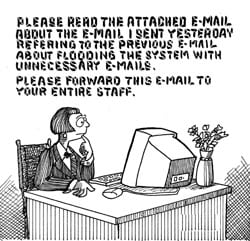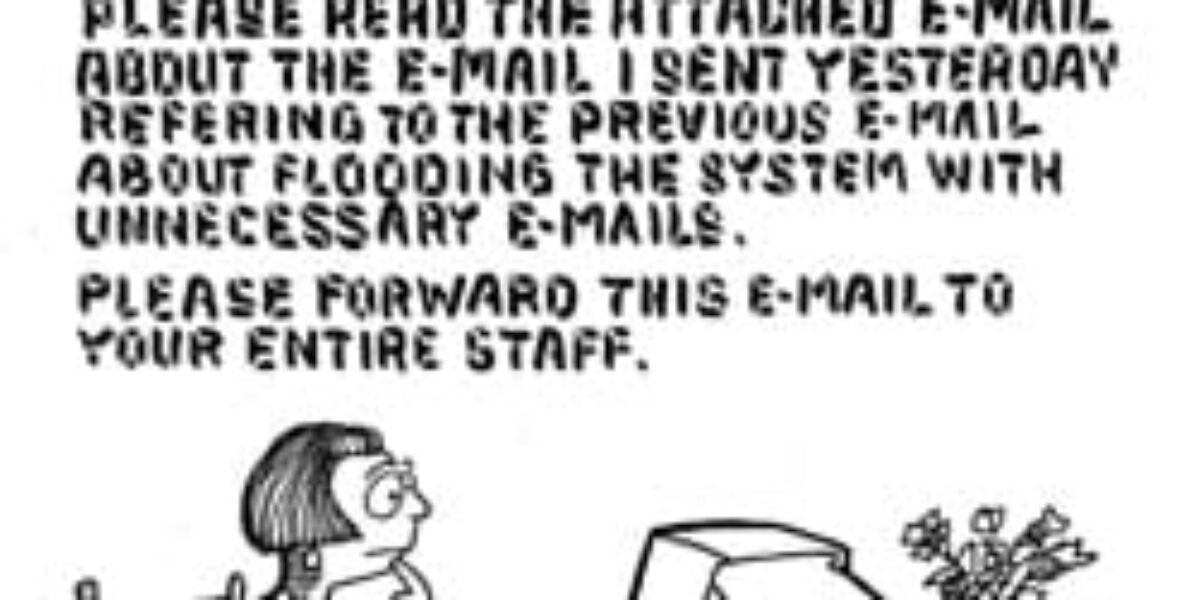The slow death of e-mail?
 E-mail was once the greatest innovation in written communication since Johannes Gutenberg had a rather clever idea regarding moveable type and printing presses. Letter writing suddenly became very old-skool, innit, and people started referring to it as snail mail. Now, however, e-mail itself is starting to go the same way as letters and, say, Prince Edward: forgotten but not gone.
E-mail was once the greatest innovation in written communication since Johannes Gutenberg had a rather clever idea regarding moveable type and printing presses. Letter writing suddenly became very old-skool, innit, and people started referring to it as snail mail. Now, however, e-mail itself is starting to go the same way as letters and, say, Prince Edward: forgotten but not gone.
A number of companies have been moving away from using e-mail as the primary means of internal communication. With most people receiving an overload of e-mails every day and feeling pressure to answer these quickly, e-mail has become a symbol of stress for employees. Organisational addiction to e-mail has reached the point of dysfunctionality, with employees sending messages to colleagues in nearby cubicles and covering their backs by cc-ing everyone else.
According to a study by researchers at University of California, Irvine, people who check their work e-mail regularly exhibit higher states of stress and less focus than workers who continue to do their jobs while being cut off from e-mail entirely. Independent research has also found that a large percentage of e-mails add little value to the individual’s or the organisation’s day. At best they are a distraction, and at worst, they result in underperformance and employee disengagement.
Studies like these convinced French multinational IT service company Atos to announce in December 2011 that it would eliminate the use of internal e-mail in the company. Thierry Breton, chief executive of Atos, estimates that his managers spend between five and 25 hours a week dealing with e-mail. He says that Atos will ban the use of internal e-mail by 2014. According to Lee Timmins, senior vice president of Atos Consulting, e-mail has become the dominant form of communication and collaboration in business but isn’t the best tool for either of these activities. He says that it is out-of-step with current developments and the habits of younger employees and clients.
Most of the young people that Atos hire do not use e-mail after graduating from university. They instead mainly use instant messaging tools and social networks like Facebook. E-mail is now considered too formal, and it is an asynchronous medium, so people don’t know whether someone has read their messages or not. For most young employees joining Atos, it was first time they had ever worked with internal e-mail tools like Microsoft Outlook.
So, Atos initiated an in-depth study to see how many internal e-mails the 80,000 employees of Atos were receiving. The study found on average that it was over 100 e-mails per day. After further analysis, some 15% of the messages were found to be useful, and dealing with the rest just resulted in lost time. Thus, in place of email, Atos rolled out a communication policy featuring three kinds of messaging: telephone, face-to-face chat and a new real-time messaging platform – essentially, a business social network tool.

Timmins says that moving to zero e-mail has meant experimenting to some extent. Focusing on messaging, collaboration and content management, it is about identifying the right tools for the task. Atos wants to create a dashboard or suite of tools configured for specific roles.
Atos was responsible for developing, integrating and operating the IT systems for the London Olympics 2012, the most connected Olympic Games in history. It delivered the core systems that enabled more than eight million ticket holders and four billion people around the world to witness the London 2012 Olympic Games. For the first time for an Olympic Games, critical key processes were zero e-mail certified. Instead, the technology team used collaboration tools to manage monitor and share information about the main critical processes of the operations.
Many companies are starting to implement enterprise social networks to promote collaboration amongst their employees. One enabling tool that is available for purchase is Yammer, which claims to bring the power of social networking to a company. Yammer says that its product is as easy to use as great consumer software like Facebook and Twitter but is designed for company collaboration, file sharing, knowledge exchange and team efficiency. Yammer lets users send messages to specific people, an entire team or as a private message to multiple recipients.
Google also offers a suite of free tools that enable more efficient communication and collaboration. When it comes to collaborating on documents, Google Docs is an excellent resource. It allows workers to share text and spreadsheets, which can be edited in real-time at the same time. Using this tool, it is possible to cut the working time on several projects in half and get more people working on the same document.
Google Talk is a good tool to keep in touch with employees for short one-on-one conversations. For groups, it can be a much better solution than a conference call because there are no awkward interruptions of other users. You just type what you want to say, even if someone else is already typing. Another essential tool is Google Voice, which allows users to answer text messages on a computer as well any other phone. Google Voice can be used to route phone calls on a regular basis. If you are going to kill off e-mail, you will have to rely on the phone a bit more, and Google Voice allows for the recording of calls for later reference.


